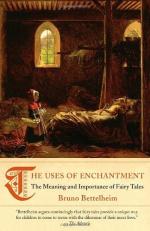
|
| Name: _________________________ | Period: ___________________ |
This test consists of 15 multiple choice questions and 5 short answer questions.
Multiple Choice Questions
1. What poet is referred to regarding the previous statement?
(a) Carroll.
(b) MacNiece.
(c) Dixon.
(d) Farley.
2. Who is the villain in the first story?
(a) Witch.
(b) Stepmother.
(c) Wolf.
(d) Queen.
3. What might be used to express inner conflict?
(a) Calamity.
(b) Hero.
(c) Prisoner.
(d) Monster.
4. Some parents and teachers have not allowed children access to fairy tales because they are _________________.
(a) Toxic and harmful.
(b) Too realistic.
(c) Confusing regarding values.
(d) Violent and frivolous.
5. Fairy tales may help a child to learn about dealing with what kind of treatment?
(a) Excessive.
(b) Preferential.
(c) Medical.
(d) Poor.
6. At what age does this phase begin to fade away?
(a) 6.
(b) 14.
(c) 19.
(d) 9.
7. What famous character has been studied by psychologists and psychiatrists?
(a) Sphinx.
(b) Oedipus.
(c) Big bad wolf.
(d) Cinderella.
8. It is said that fairy tales manage to give children which of the following?
(a) Inferiority complexes.
(b) A skewed view of life.
(c) Sense of humanity.
(d) Sense of belonging.
9. Regardless of the content of the story, what two cultures call all such stories fairy tales?
(a) French and African.
(b) Danish and Norse.
(c) Swedish and English.
(d) English and French.
10. The monsters or evil people in the stories always finish the story as _________________.
(a) Evil.
(b) Remorseful.
(c) Good.
(d) Reformed.
11. Which part of the mind is not fed by fairy tales?
(a) Superego.
(b) Ego.
(c) Id.
(d) Conscience.
12. What is not offered to the fisherman?
(a) Three wishes.
(b) Safe way home.
(c) A new boat.
(d) Gold.
13. What does the fisherman find in his net?
(a) Copper pot.
(b) Talking fish.
(c) Mermaid.
(d) Nothing.
14. A child is unable to understand _________________.
(a) Resourcefulness.
(b) Motive.
(c) Evil.
(d) Duality.
15. Through fairy tales, children are led to believe that _____ will always come to their aid.
(a) A monster.
(b) A benevolent force.
(c) Magic.
(d) Parents.
Short Answer Questions
1. An adult may see the relationship between the wolf and the grandmother as _________________.
2. In the example, where does the child live?
3. What is the first fairy tale mentioned in this section?
4. It was predicted that Oedipus would kill who?
5. Who is the first famous writer to be quoted in chapter one?
|
This section contains 337 words (approx. 2 pages at 300 words per page) |

|




